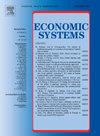技术追赶、非单调性和趋同:来自金砖五国和欧洲银行体系的参数证据
IF 3.3
2区 经济学
Q1 ECONOMICS
引用次数: 0
摘要
信息技术驱动的生产率增长为银行提供了一个引人入胜的机会,使其能够在垄断市场上提供与众不同的产品,推出有吸引力的产品,加强客户服务,简化后台流程,并最终实现成本最小化和利润最大化的双重目标。然而,对于所观察到的信息技术与生产率之间的差异,却没有令人信服的解释,这不禁让人怀疑信息技术能否显著提高当代银行业市场的绩效。本文通过研究信息技术在影响金砖五国和欧洲银行业市场基于前沿的效率方面的潜在非单调性,探讨了信息技术带动的生产率增长在管理行业内和国家间趋同的方向和幅度方面的作用。研究结果表明,信息技术与成本(利润)效率之间存在 U 型关联,这表明过度的信息技术投资可能是金砖国家生产力难题的原因。对于欧洲国家而言,信息技术资本并不是成本效率的重要驱动因素。然而,研发支出对前沿效率有重大影响,这进一步说明欧洲银行可以通过投资创新解决方案实现前沿水平的业绩。地区间比较显示,金砖五国银行通过利用信息技术解决方案,正在向欧洲同行靠拢,而欧洲同行的边际效益递减则强化了赶超效应的存在。行业内比较显示,规模、年龄和研发强度推动了技术赶超和趋同。本文章由计算机程序翻译,如有差异,请以英文原文为准。
Technological catch-up, nonmonotonicity, and convergence: Parametric evidence from the BRICS and European banking systems
IT-driven productivity growth offers banks an intriguing opportunity to differentiate their offerings in a monopolistic market, introduce attractive products, enhance customer service, streamline back-office processes, and ultimately achieve the twin goals of cost minimization and profit maximization. However, there has been no convincing explanation for the observed divergence in the IT-productivity literature, raising doubts about whether IT can significantly improve performance in contemporary banking markets. The article examines the role of IT-led productivity growth in governing the direction and magnitude of intra-industry and inter-country convergence by investigating the potential nonmonotonicity of IT in influencing frontier-based efficiency of the BRICS and European banking markets. Findings reveal U-shaped associations between IT and cost (profit) efficiency, suggesting that excessive investment in IT may explain the productivity conundrum for BRICS nations. IT capital is not a significant driver of cost efficiency for European nations. Nevertheless, R&D spending significantly influences frontier efficiency, reinforcing that European banks can achieve frontier-level performance by investing in innovative solutions. Inter-regional comparisons reveal that BRICS banks are converging with their European counterparts by leveraging IT solutions, while diminishing marginal benefits for the latter reinforces the presence of a catch-up effect. Intra-industry comparisons reveal that size, age, and R&D intensity drive technological catch-up and convergence.
求助全文
通过发布文献求助,成功后即可免费获取论文全文。
去求助
来源期刊

Economic Systems
ECONOMICS-
CiteScore
4.90
自引率
0.00%
发文量
83
审稿时长
48 days
期刊介绍:
Economic Systems is a refereed journal for the analysis of causes and consequences of the significant institutional variety prevailing among developed, developing, and emerging economies, as well as attempts at and proposals for their reform. The journal is open to micro and macro contributions, theoretical as well as empirical, the latter to analyze related topics against the background of country or region-specific experiences. In this respect, Economic Systems retains its long standing interest in the emerging economies of Central and Eastern Europe and other former transition economies, but also encourages contributions that cover any part of the world, including Asia, Latin America, the Middle East, or Africa.
 求助内容:
求助内容: 应助结果提醒方式:
应助结果提醒方式:


